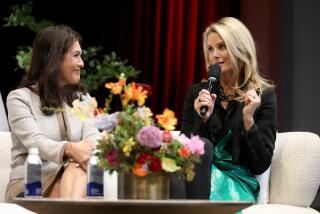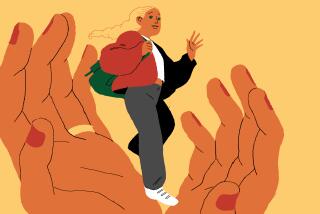Schoolbooks and Baby Bottles : Unwed Long Beach Mothers Under 16 Get Day Care, Support, Place to Study
LONG BEACH â The worst thing about mothering, according to Esperanza Saucedo, is that it cuts down on running and playing.
âYou feel so much older,â the wide-eyed youngster sighs. âWhen you go to the store you want to get candy and stuff, but you have to get baby food. I used to go out and buy bracelets; now thereâs no time.â
Saucedo is 14. Her baby, Andrew, is 5 months old. Ever since February, they have had a place to grow up together, courtesy of the Long Beach Unified School District--the interim school for junior high school mothers, the districtâs first program for children age 15 and under who have given birth.
âI like it here,â the girl says while changing a diaper during a break from the morningâs lesson in fractions. âItâs better than leaving your baby with a sitter. You donât find that youâre in a world by yourself; you can discuss your problem with other girls who have the same problem.â
Pregnancy has for some time been a problem among teen-agers. Whatâs new, Long Beach educators say, is the spiraling birth rate among girls as young as 12. âThe moral standards seem to be dropping,â said John Lepick, principal of Reid High School, the districtâs continuation campus, which for several years has maintained classes for pregnant youngsters of all ages.
Ten years ago, Lepick said, fewer than 10% of the schoolâs pregnant students were 15 or under, all of them in the ninth grade. Today that group has tripled to more than 30%, including a liberal sprinkling of girls in grades six through eight.
âNobody even looks twice at a pregnant young girl (on our campus),â Lepick said, âbecause you see them all the time.â
Upon giving birth, those who are 16 can enroll as regular students at Reid, which provides day care facilities for their babies while the girls attend class. In the past, those who were under 16 had only two options: Find full-time day care for their children and attend a regular junior high school, or--the more likely choice--drop out of school altogether to take care of their babies.
All that changed three months ago when, armed with a state grant, the district opened the interim junior high school on the third floor of a separate day care center near Pine Avenue and Anaheim Street in central Long Beach.
Although only seven girls are enrolled, coordinator Pam Miller said, the school is in touch with another five to eight who are being encouraged to attend class. In 1982, she said--the last year for which statistics are available--72 babies were born in Long Beach to girls age 15 and under. Yet last year, she said, the district dealt officially with only 16 such cases--an indication, she believes, that many are falling through the cracks.
âMy sense is that they are out there,â Miller said. âMotivating them to go to school is hard.â
Those who do attend the interim school find an educational setting far more tranquil than that of the average junior high school. Seated around a table in the three-room suite opening out to a rooftop patio, the girls study math, English, social studies and science under an experienced teacher while their babies sleep in nearby playpens or relax in infant swings. Studies are frequently interrupted for nursing or diaper changing. Two afternoons a week, a second teacher visits the young mothers to teach them parenting skills, family and consumer matters and child development.
Emotional Support
Administrators say the goal of the program is twofold: to enable the students--most of whom still live with their parents--to keep studying long enough to graduate to Reid High School and eventually become self-sufficient; and to give them the kind of emotional support they need to get through what, to many, has been a crisis.
âWe want them to have some sense that theyâre OK and that they (can) continue to do something more with their lives,â Miller said. âWe also want them to understand their babies.â
She attributes the trend toward earlier motherhood to a combination of factors, including harsh economic conditions and changing sexual mores. âThese girls are vulnerable,â she said. âTheyâre young, the guys they are with are older and most of them come from families where they donât see a big future. This is a way for them to feel successful at something; they can have babies.â
Students in the district routinely receive sex education in the fifth and sixth grades and again as part of health education classes in grades seven and 10. To help stem the tide of teen-age pregnancies, Miller advocates beginning the classes as early as third grade and expanding them to emphasize the immediate and long-term consequences of parenthood.
âWe have to somehow help (students) see that it is in their best interest to delay sexual activity or use contraceptives,â she said. â(We need) to help change their assessment of the future.â
For some in the interim school, that process already seems to have begun.
âI want to have a good education so I can have a good future,â Saucedo said.
Added Marilyn Burns, also 14: â(With an education) I wonât have to be low-class.â
Teacher Jody Dean says she welcomes such insights as steps in the right direction. But as important as the academic progress, she says, is the less tangible emotional component of what goes on in her classroom. âI would hope this could be a place they could find some love and some caring,â Dean said of her students. âI donât want them to feel like outcasts.â
More to Read
Sign up for Essential California
The most important California stories and recommendations in your inbox every morning.
You may occasionally receive promotional content from the Los Angeles Times.










